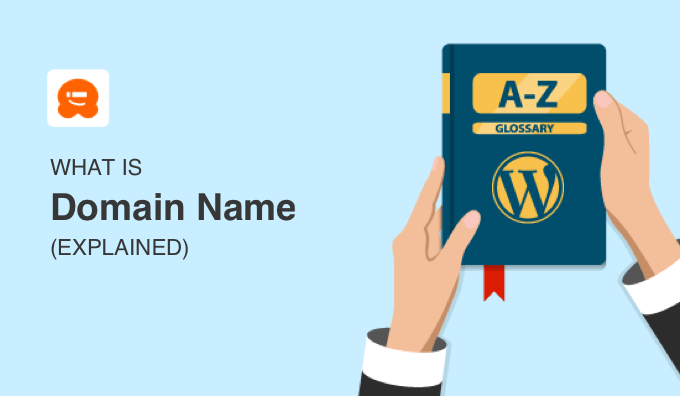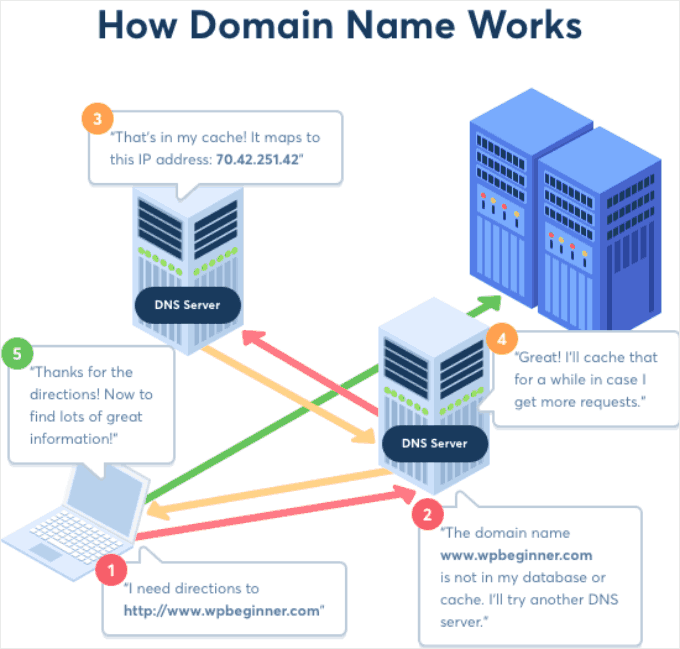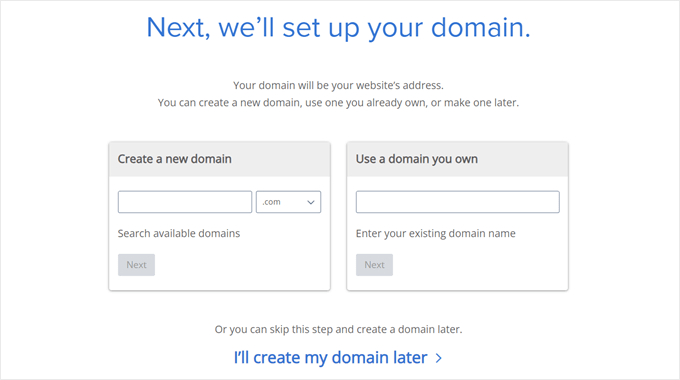A domain name is like a website’s address. It’s the name you enter into a web browser’s address bar to navigate to a website.
In simple terms, if you think of your website as a house, then your domain name would be the physical address identifying it. An example of a domain name is wpbeginner.com.

What Is the Difference Between a Domain Name and Web Hosting?
A domain name is a web address that leads internet users to a website. Meanwhile, hosting is a web server space where a site’s content, files, and data, are located.
To create your website, you need both a domain name and a hosting service. Without web hosting, you cannot publish your website, even if you already have a domain. Without a domain name, users can’t easily access your site.
You can learn more in our guide on the difference between a domain name and web hosting.
What Is the Difference Between a Domain Name and an IP Address?
IP (Internet Protocol) address is a long string of numbers that identify a website on the World Wide Web. Since numbers are hard to remember, domain names are created to correspond to IP addresses and make it easier for people to access websites.
The internet’s Domain Name System (DNS) is like a phone book. When you type in a domain name, it automatically looks up the number and the IP address and connects you to the website.
Every website has a unique, associated IP address to identify it on the internet. A typical IP address looks like this:
66.249.66.1
You can learn how domain names work in detail in our beginner’s guide on what domain names are and how domains work.

What Is the Difference Between a Domain Name and a URL?
A domain name is the main part of a web address, like wpbeginner.com. Meanwhile, a URL (Uniform Resource Locator) is the complete web address that includes the domain name plus additional information, like the specific web page or file you want to access.
A URL is like giving directions to a room inside a house. For example, in the URL https://www.wpbeginner.com/wordpress-seo/ the domain name is wpbeginner.com and the rest of the URL (/wordpress-seo) tells your browser to go to our ultimate WordPress SEO guide.
You can learn more about URLs and parts of a URL in our beginner’s guide to what is a website URL.
What Is a Subdomain?
A subdomain is a type of domain that you create as a branch of your main website. It’s like making a separate section within your site, such as blog.example.com or shop.example.com.
In the examples above, the ‘blog’ and ‘shop’ parts of the address are called the third-level domain.
To set up a subdomain, you typically need to configure your nameservers to ensure the internet traffic goes to the right place. You can learn more about this topic in our ultimate guide to DNS configuration.
What Is a Top-Level Domain (TLD)?
A top-level domain (TLD) is the part of a website’s address that comes after the domain name and the dot, like .com in wpbeginner.com or .org in wikipedia.org. It’s also called the domain name extension.
Meanwhile, the website address that comes before the TLD is called the second-level domain (SLD). So, in example.com, the SLD is ‘example.’
One popular type of TLD is a generic top-level domain (gTLD). gTLDs are domain extensions that have an intended purpose based on their names.
For example, .com stands for ‘commercial,’ but many non-commercial sites use it because most internet users are familiar with it. .org, .gov, and .edu are also examples of gTLDs.
There are also country-code top-level domains (CCTLDs), which can identify websites that operate in or target users in a specific location.
For instance, if a domain name ends with .co.uk, that means the business operates in the United Kingdom.
Which Domain Name Extension Should I Use?
In general, the best practice is to go with a .com domain name. Most internet users are familiar with it and expect most domain names to end with .com, so using it will make your website more memorable.
However, some people consider .com too expensive for new users. That’s why many choose to use new, more affordable domain extensions like .xyz or .online. Some also use niche TLDs like .pizza or .photography to make their brand stand out.
Do approach these newer extensions with caution as they can make your website look spammy to users. You can read about the pros and cons in our guide on whether you should choose a new domain extension for your website.
If your online business is focused on a particular country, using a ccTLD like .de for Germany or .fr for France could be a good idea.
It can make local customers feel more comfortable buying from you because they see you as connected to their country. Do note that some of these domains can only be registered if you are located in that country or have a representative there.
How to Choose the Perfect Domain Name
Here are some top tips for choosing the right domain name for your website:
- Stick with .com.
- Use your business name.
- When possible, include a relevant keyword in your domain name.
- Keep it short, easy to pronounce, and easy to spell.
- Avoid hyphens and double letters.
- Make sure it looks good as a business email.
- Use a domain name generator to get ideas.
- Make sure it’s future-proof so that you won’t have to change it down the line. Doing this can damage your brand and lower your search engine rankings.
For more information, check out our full guide on how to choose the best domain name.
Once you have some name candidates, make sure to check if the domain is available. You might find that the domain name you wanted to use is already taken. The easiest solution is to choose a different domain name that is available.
But, if you want to consider purchasing a domain name that’s already in use, then you’ll need to find out who actually owns it in the WHOIS database. Also, read our tips on how to buy already registered domain names to decide whether it’s the right move for you.
How to Register a Domain Name
You can register a domain name by going to a domain registrar. Just type in your desired domain name, complete the purchase, and verify you are the domain owner via email. Once done, your domain name will be live.
Choosing a reputable domain name registrar is important because there are so many ways to get tricked. You can learn the pros and cons of different companies in our guide on how to choose the best domain registrar.
A .com domain name typically costs about $12.99/year, but the price varies by the registrar. Some premium domain names may cost hundreds of dollars or more due to being short, memorable, and keyword-rich.
Our recommendation is to register your domain with Domain.com as it has more than 300 domain extensions available at affordable prices.
Many hosting providers like Bluehost also offer free domain name registration with their hosting plan and even a free SSL certificate. This way, you can get more value for your money.

Additionally, website builders like WordPress.com or Wix also include free domain names.
For step-by-step instructions, you can read our tutorial on how to properly register a domain name. We also answer frequently asked questions and show you how you can get a domain name for free.
We hope this article helped you learn more about domain names in WordPress. You may also want to see our Additional Reading list below for related articles on useful WordPress tips, tricks, and ideas.
If you liked this article, then please subscribe to our YouTube Channel for WordPress video tutorials. You can also find us on Twitter and Facebook.
Additional Reading
- IP Address
- How to Find Out Who Actually Owns a Domain Name? (3 Ways)
- How to Buy a Domain Name That is Taken (9 Pro Tips)
- How Much Does a Domain Name Really Cost? (Expert Answer)
- The 8 Best Domain Name Registrars in 2025 (Compared)
- Beginner’s Guide: What is a Domain Name and How Do Domains Work?
- What’s the Difference Between Domain Name and Web Hosting (Explained)
- Here’s How I Register Domain Names (& Get Some for Free)
- 7+ Best Places to Find Premium Domain Name for Sale (+ Expert Tips)
- DNS




